Nellie and Her Italian Soda, Boulder
- Robert Benjamin, American, 1947-
- Born: Chicago, IL
- Work Locations: Fort Collins, CO, Seattle, WA
Born in Chicago in 1947, Robert Benjamin lived in Paris for several years in his twenties before moving to New York City. There he was introduced to the work of photographers he admired, like Helen Levitt, Garry Winogrand, and William Eggleston. He bought his first camera and started to make photographs of the subject he found most interesting and accessible—his own life. He has since lived and worked in Santa Fe, New Mexico; Sarasota, Florida; Seattle, Washington; and the Colorado Front Range. He currently lives in Fort Collins, Colorado.
With no formal training, and no academic or commercial agenda, Benjamin cherishes the freedom to function independently. “I’m just a dad with a camera,” says Benjamin. “I started photography for the same reason any artist does, but I didn’t have the same influences, I didn’t have to please anyone but myself.” Since 1970, he has photographed or worked in a darkroom processing photos nearly every day, while earning his living outside the photography field (mostly in retail sales). He has never been represented by a gallery, and has refused to participate in museum or gallery exhibitions, but he sometimes trades his prints with America’s leading artists, who consider him a peer. After decades of saying no, his friend and DAM photography curator Eric Paddock convinced him to allow the Denver Art Museum to mount his first solo exhibition, Notes from a Quiet Life, in early 2011.
Of his photographs, Benjamin says, “I wasn’t trying to achieve anything other than satisfy my own sense of beauty. I made [my photos] to satisfy something I had never seen before in other photography; I knew of no other photographer that’s photographed his family from birth to death. I was tired of seeing contrived project pictures and angst and social comments about the world ending. That’s all easy to me. To accept love and to accept mystery is not as easy.” Benjamin describes his photos as being “about four different things: they’re about love, they’re about family, and they’re a combination of color and light.”
Benjamin’s kids grew up completely comfortable with the fact that Dad always had a camera in his hand. But while Benjamin’s subjects are often members of his family, his choice of subject and moment is more about what he sees formally. Referring to this photo of his daughter Nellie, he says, “For me it’s simply a good color photo… The fact that it’s my daughter is secondary.” He goes on to say, “To me, that’s an extraordinary picture…everything about it is beautiful. And that’s why I want people to look at it. Not just her, but every edge is beautiful. Every color is just glowing…”
Benjamin is very partial to both the process he used to print his photographs and the paper on which he printed them, because of the quality of color he is able to achieve. This paper was discontinued by the manufacturer in 2009, so it is unclear whether Benjamin will ever find a way to make more prints that meet his requirements, or if he will simply discontinue printing his work. “These are called C prints…they are prints off of negatives. If you took your film to a one hour lab in the old days, it’s the same process I’m using. They look a little different because I had bigger paper, and I could make it myself. That process is now a casualty of technology, it’s pretty much gone. And it was a unique process, very beautiful. It allowed me to make the colors I want appear on paper, which I could probably not do digitally, which I could not do with slides, so it was a very intimate and very personal process…Digital cannot hold these tones, there’s no question about that. So my sense of beauty was tied into the process.”
Details

Subject Matter
Benjamin acknowledges that to him, the most beautiful moments in life are “kind of non-events.” He says, “These pictures, to me, are a little bit like poems. To me, a poet takes what’s familiar and gives it back to you in a way that’s taught you something about what’s familiar.” His photos encourage people to see the beauty in everyday life. “I think everyone sees beauty every day, they just don’t always stop and acknowledge it. I think you have to acknowledge it.”
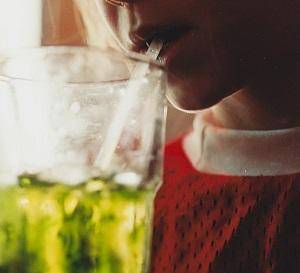
Color
The photograph is dominated by two strong, complementary colors—the striking green soda and Nellie’s red jersey—with the brightest parts meeting each other near the center of the picture. Sunlight filters through the green liquid and grazes across the red shirt. Both areas of color are topped by a band of white—the white created by the highlights at the top of the glass and the white of Nellie’s collar.
Benjamin likes saturated color, and he points out that he doesn’t print his photos to reproduce color that is chromatically accurate, but rather emotionally accurate—that is, the quality of color that feels right to him.
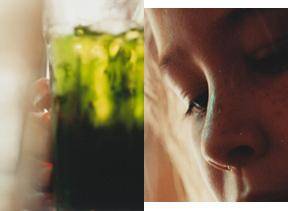
Color Highlights
Notice the fragments of red light on Nellie’s fingertips to the left of the glass, and the greenish reflection on the bridge of her nose. Each provides an echo of the larger red and green areas, but they don’t match; they introduce new shades of green and red into the palette.
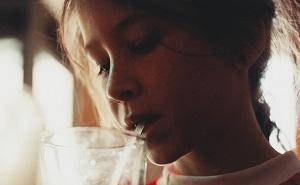
Natural Light
Benjamin likes shooting with natural light; he doesn’t use a flash. In this picture, the backlighting from the window permeates the two clear drinking glasses and throws Nellie mostly into shadow. It also creates a halo-like effect where Nellie’s hair frames her face on the left and floats away from the back of her head like rays.
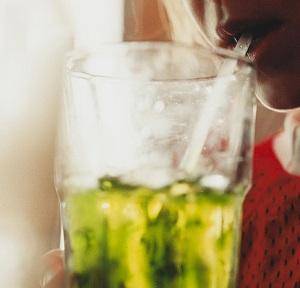
Focus
Benjamin shoots most of his pictures from a distance of about 3–10 feet, and with a narrow depth of field, meaning that when he puts one part of the scene in sharp focus (in this case, Nellie’s face), almost everything closer or farther away will be blurry. Notice that the straw in Nellie’s mouth is in clear focus, but as you follow it down into the glass, it takes on the soft focus of the glass itself, which is a bit closer to the camera than Nellie’s face is.
By leaving the soda out of focus, Benjamin emphasized the color of the liquid and the soft-edged shapes of the different shades of green, rather than describing the contents of the glass
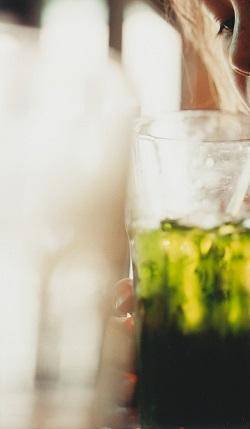
Empty Glass
Don’t miss the extreme blurring of the empty glass (probably Benjamin’s own) along the left edge, which gives the picture its foreground and creates a sense of depth.
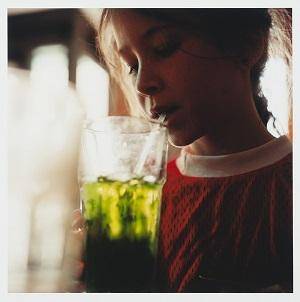
Edges
When he shoots a photo, Benjamin is very conscious of his distance from the subject and how he’s filling the frame of the photo. A picture that gets it right, for him, usually has “good edges” in terms of light and color. Speaking about this picture, he says, “I like the color that’s in the edges, besides her beautiful green soda.”
More Resources
Websites
Notes from a Quiet Life
Listen to a Colorado Public Radio interview of the artist Robert Benjamin and Denver Art Museum Curator of Photography, Eric Paddock recorded December 1, 2010 on the occasion of Benjamin's first solo exhibition at the DAM titled "Notes from a Quiet Life."
Wisdom From Robert Benjamin
Read about some of Robert Benjamin's thoughts about modern art in this post published on the Denver Art Museum's blog, The Collective.
Photo Exhibit Reminds Me of Home
In this post from The Collective, you can read about one blog post writer's personal connection to Robert Benjamin's photographs.
Funding for object education resources provided by a grant from the Morgridge Family Foundation. Additional funding provided by the William Randolph Hearst Endowment for Education Programs, and Xcel Energy Foundation. We thank our colleagues at the University of Denver Morgridge College of Education.
The images on this page are intended for classroom use only and may not be reproduced for other reasons without the permission of the Denver Art Museum. This object may not currently be on display at the museum.
